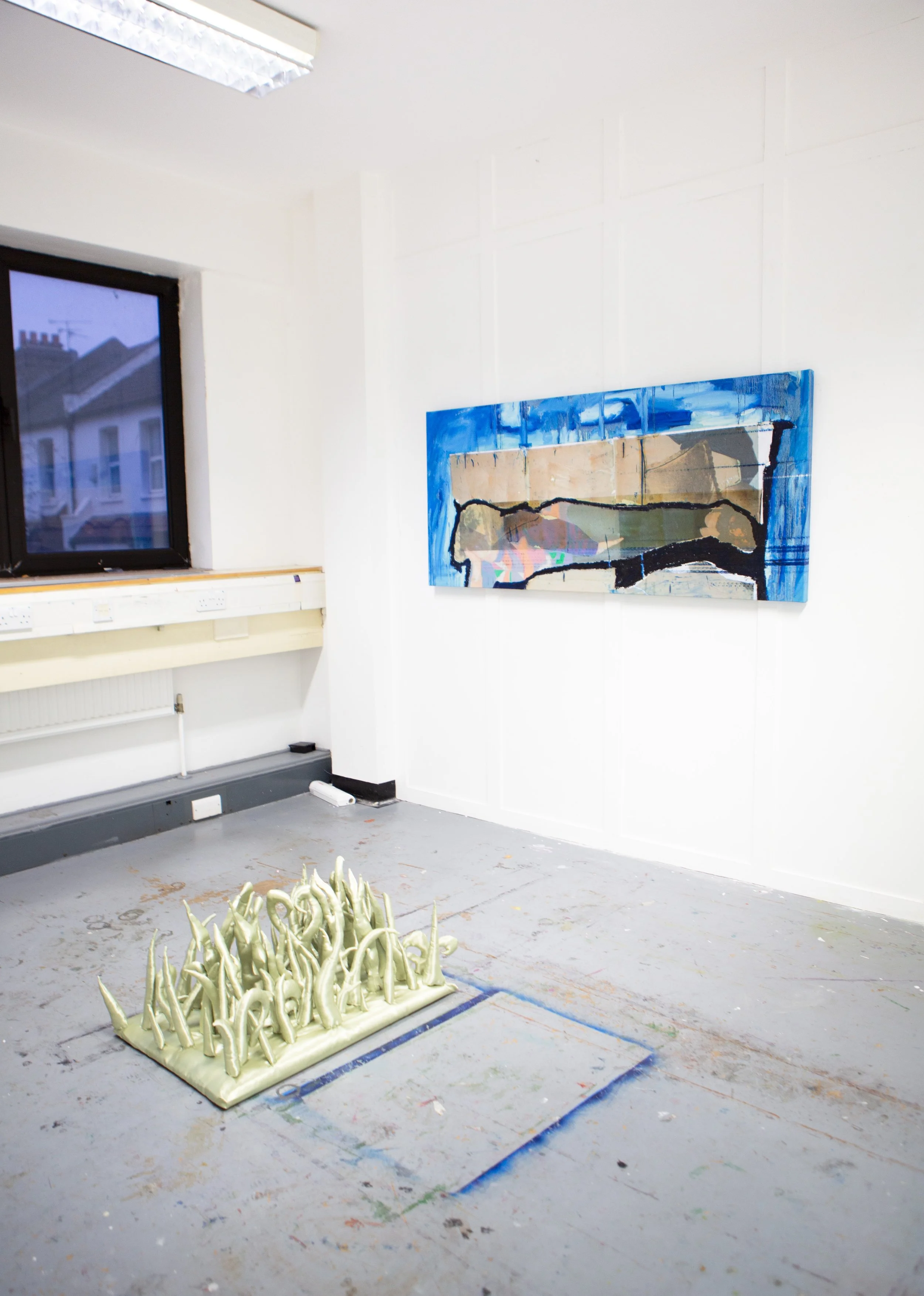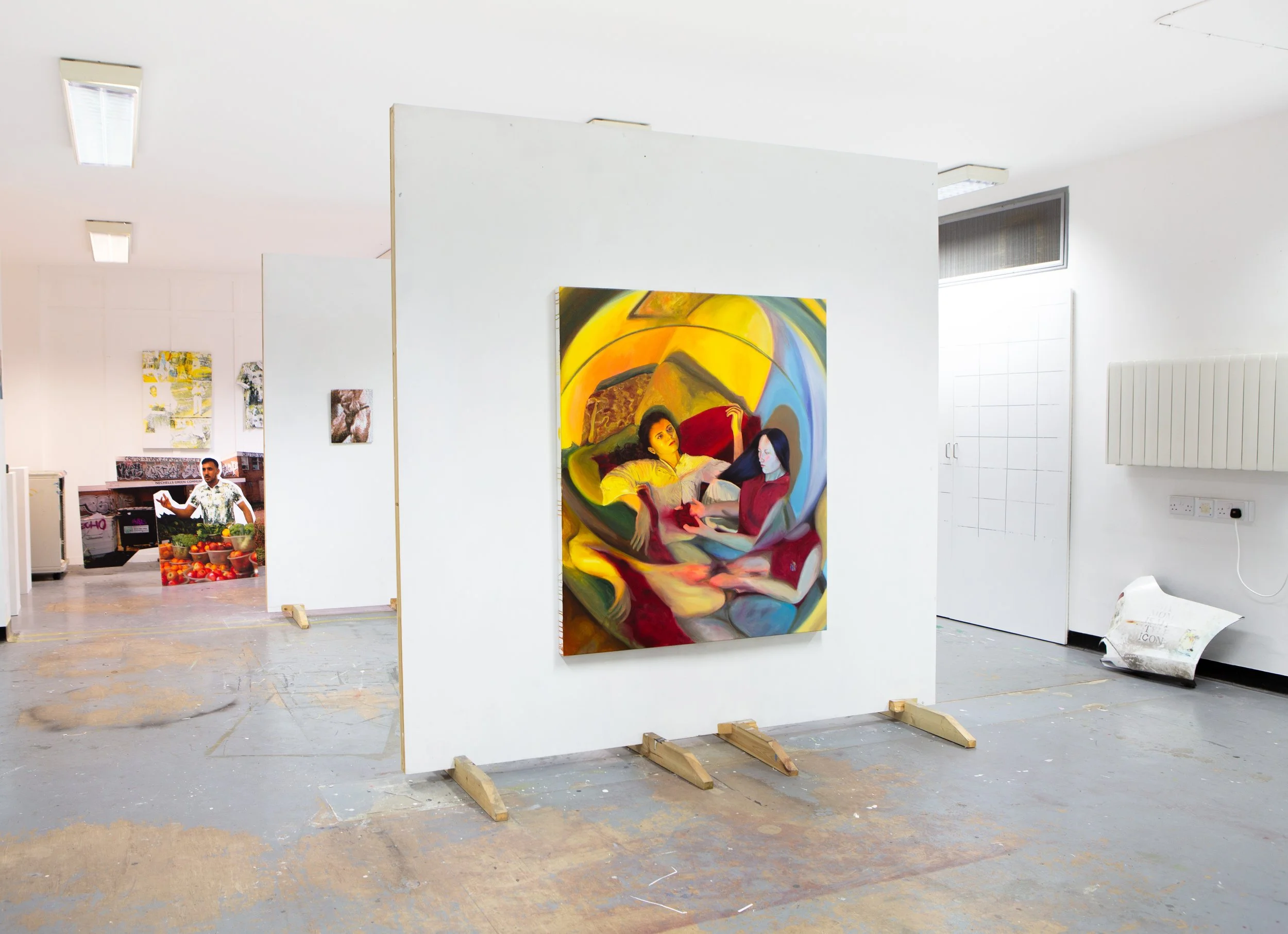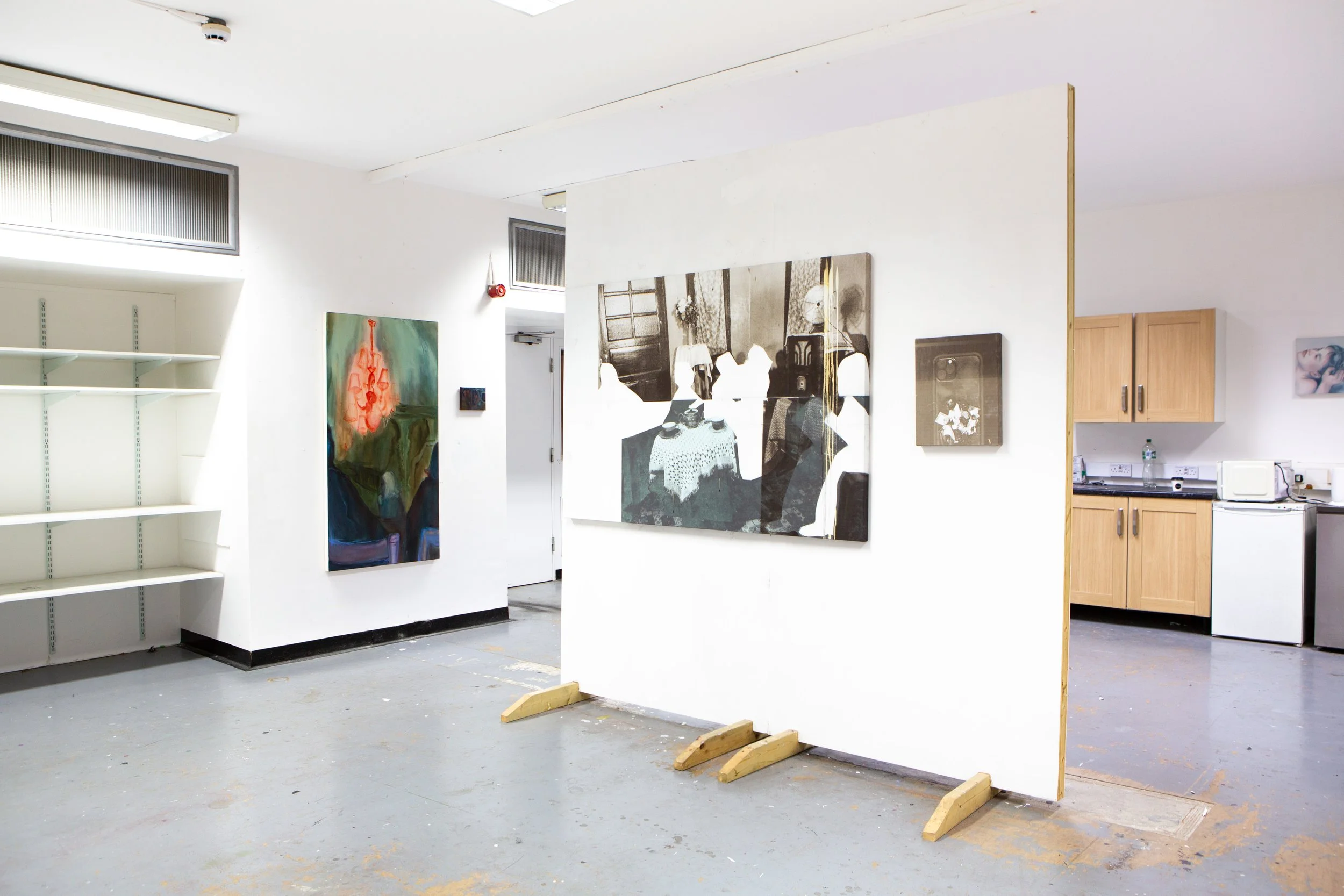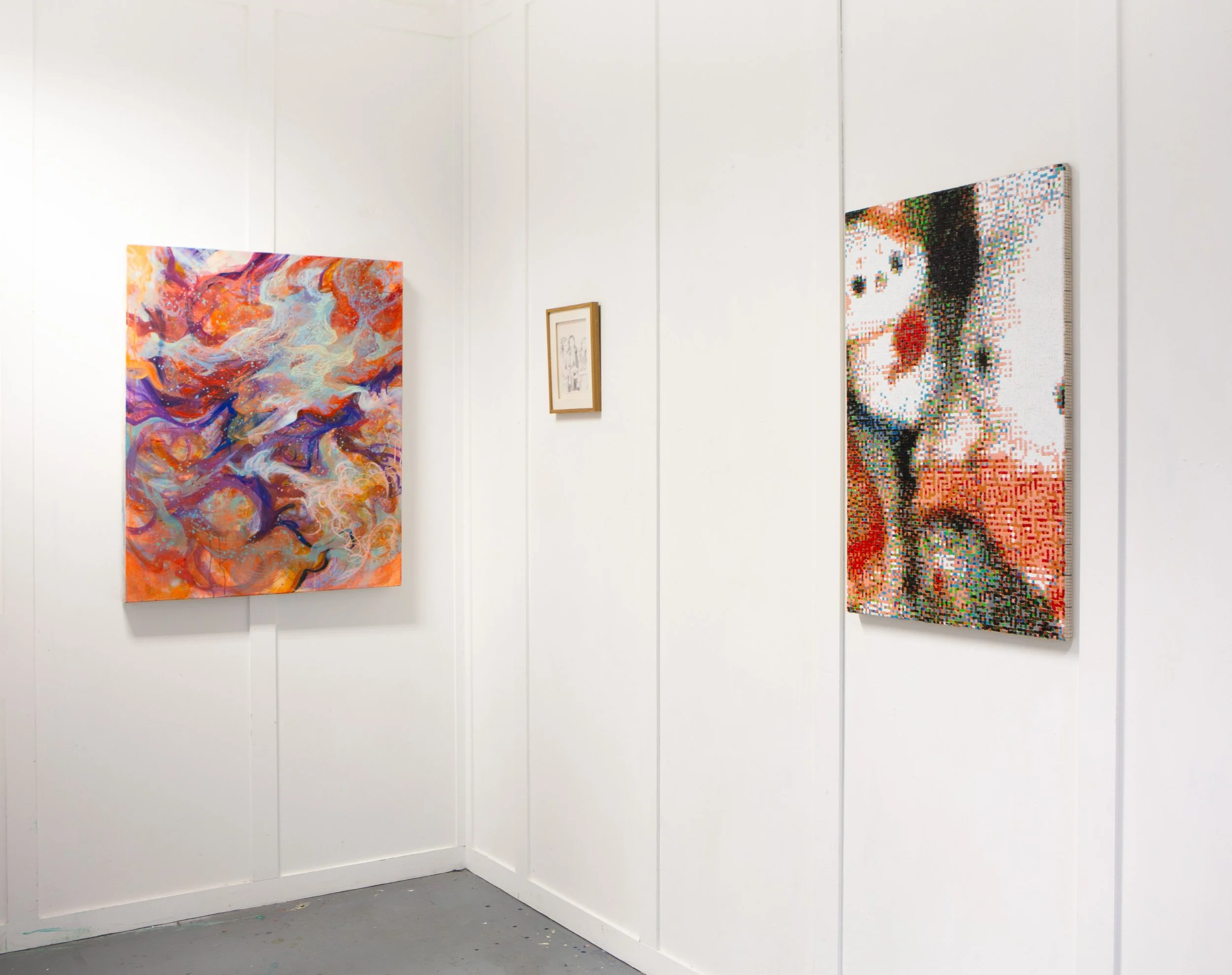Autumn 2024
Daddy Bears, Lily Bunney, Harriet Gillett, Freya Fang Wang, Derrelle Elijah, Amelie Peace
Daddy Bears
Daddy bears is an artist based in London. She received her MA in Menswear Design from the Royal College of Art. She uses her knowledge of pattern cutting for garments to create 3d objects away from the body. To be able to fill a space with twisted fantasy sculptures feels like a fresh take on traditional techniques which are rarely seen to be manipulated in this way. The use of intense repetitive hand sewing featured throughout her practice is a testament to ‘women’s work’ and a meditative labour of love. These intimate techniques are used to help emote feelings of romance, escapism and humour. Her work also references ideas of transitional objects, childhood and adult forms of play, and a nostalgia for obsessive toy collections. Her recent solo show- Shiny, Sexy, Soft with Roman Road gallery displayed a mixture of fantasy furniture like sculptures shown in parallel with large digitally printed wall hangings.
Lily Bunney
I’m a London based artist whose work looks towards labour, production, and emotional technologies. Care work has always fueled the economy. My art aims to locate new visual and oral languages which depict some of the relationships between technology and care. Recently I have been taking inspiration from social media, and public figures whose online influence is partially devoted to the exploration of trauma. In these people I see a multiplicity, their art gaining them social and material capital whilst their tales of trauma becoming both content and meaningful points of connection between creator and audience. My current primary visual language, large scale pointillist drawings, visualises these points between digital technologies and physical labour. They reflect a certain neuroticism, the obsessiveness that goes into creating them capturing a growing cultural tension bubbling underneath late stage capitalism. My writing is rooted in science fiction, and recently has been devoted to unpicking the body horror genre as a site where desire and physicality collide. Labour as care, love as written about by bell hooks, queerness and sexuality, collide with labours of production through the advent of an information economy, creating these fascinating moments where our bodies, souls, and machinery, interact in new ways.
Harriet Gillett
Responding to an increasingly digitalised world where images and time periods merge and appear in one seemingly eternal present, Harriet Gillett hopes to slow down these increasingly fast-paced encounters into images of reverie. Taking reference from the emotionally charged vibrancy of post-Impressionism and the devotional nature of Western religious formats, her combination of traditional subjects with contemporary materials enables her to tread a line between multiple perspectives and time periods. She works from sketches made in the moment, usually of friends in pubs and at live gigs, later attempting to capture the memory of these communities and atmospheres within her paintings. Working predominantly with oil and spray paint, she layers thin veils of colour over a warm fluorescent spray paint ground that is reminiscent of the gold within icon paintings and a “rose- tinted” lens. This enables the work to position itself between the past and present, the traditional and the contemporary, both in terms of its imagery and its materiality. Paint operates as a metaphor for both instability and potential transformation, allowing for a fluidity of form, blurring the line between the experienced and the imagined. The same images are repeated across multiple scales, shifting personal memories into the symbolic realm. She often uses lyrics from songs and literature within the titles or sides of paintings to add another layer of perspective. The paintings become dreamlike and lyrical explorations of identity; moving between intimate snapshots that evoke something more personal and scaled-up sketchbook pages that take on an immersive and more universal quality.
Freya Fang Wang
Deeply rooted in Chinese philosophy and culture where she was born and raised in,Freya’s practice is focusing on the interconnection between Taoist philosophy and her immersive experience of the natural world. She always feels strong energy connecting through between the earth and heaven, while she is in nature. Inspired by the personal epiphany, her works seek to celebrate the coexist- ence between life forms, while excavating the spiritual power of the natural world , also inspiring the questions about our relationship and our place in the cosmos in the context of the anthroposcene. Through the meditative painting process, engaging her bodily awareness and consciousness into the field in the canvas, Freya taps into vibrations of the cosmic energy field in the universe. In so doing she explores the Taoist concept of interconnection and oneness. Freya understands the narrative way in her paintings as building the infinite energy fields inside the canvases, All the marks and layers appearing in the process are created intuitively. Based on the interaction with the imagery, the fields are building up as the dynamic endless webs emerging gradually which connected all creatures in the nature. Freya always provides herself with a dramatic area of colour to inspire rich colour clashes and variations, which may have something to do with her fondness for images of the ocean, the stars, the universe, and the polar lights. She combines oils, acrylics, inks and plaster to create intertwined marks compositions in ethereal paintings, which in turn powerfully express the rich and diverse interconnectedness of everything in the universe.
Derrelle Elijah
Derrelle Elijah (b.1994, Birmingham) live and works in London.
My work explores the relationship between analogue and digital processes, ranging from painting, printmaking, sculpture and installation based works. Focusing on a range of themes that deal with social contemporary issues. I develop artworks that transcend mediums and re-contextualise how information is communicated, allowing the audience to go beyond the obligatory image. Starting with a function free mentality; an intrinsic overlay of research into early civilisations, universal language, traditional/forgotten processes, art history and contemporary news allows allows my work to start with an investment into investigation and ideation. Juxtaposing non- traditional combinations with redaction to create a coherent piece/series of work.
Quoting Jan Van Toorn who believes that ‘media gives us a strongly reduced distorted view on reality’ I believe that society is a visceral overload and that we are constantly bombarded by images. Due to this there is lots of information missed in-between, this is where I take a deep dive. I illuminate these realms by allowing my work to start a cultural conversation by highlighting these grey areas, allowing the audience to go beyond the artwork presented to them. I believe the art world is widely ostracised, in attempt to break down these barriers I want to speak to audiences outside of the art-world through the art-world. I want to allow audiences to feel connected to my work by allowing them access both physically and mentally. In addition to this, I aim to flip the ‘gift-shop’ narrative on it’s head. All work is the work, no matter which version you get, you’ve got it.
Amelie Peace
Amelie Peace is a French artist based in London, and she examines the human condition using wrapped figuration, and the construction of ‘intimacy-landscapes’ through painting and printmaking. She seeks to refine the art of gesture by carefully composing images that tinker with the sexual, emotional and social ideologies around touch and physical connectivity. Her characters, interlaced with one another often render a sense of physical dependence, as if the figures once shared a body. They depict how every exchange with another person alters our understanding of our own bodies. Peace’s work serves as a mirror for both her personal life experiences, and observations of the world around her. Her images probe at human behaviour, unpicking the complex tensions around intimacy and control. Intentionally ambiguous, the psychophysical dialogues she explores invite interpretation, leaving ample space for individual reflection and emotional engagement. She employs colour and texture as expressive tools, strategically placed to emphasise the nuances within the narrative. Hands play an important role in Peace’s exploration, whether in action or at rest, they serve as symbolic elements guiding viewers through the complexities of the relationships depicted. They are signposts in amongst the chaos, anchors within the complex compositions she explores. Each gaze is confronting, demanding the viewer to engage with the theatrical puzzles that Peace has crafted in her pursuit to illuminate the complexities of human emotion.





